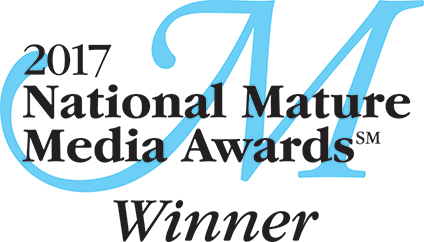Courtesy of STC Craft | A Melanie Falick Book
Photograph by Debbie Patterson
Kaffe Fassett is a world renowned artist and designer who uses color to change the ordinary to the extraordinary. Born in California, he has lived in London for more than 40 years.
At what point did you realize that art was your passion? What did you do before you became successful?
At the age of 4 years old I was given a set of oil paints and an easel, so I guess I must have shown promise - I was always attracted to the visual in life. Before I became successful as a textile artist I concentrated on fine art painting.
Your parents have utilized their creative skills in the restaurant business in California. Were you encouraged creatively at a young age?
My mother was the creative one in our family and she encouraged me always – sending me off to any visiting theatre, or dance group or classic films like The Red Shoes and Olivier’s Henry the 5th.and supplying me with art books.
What prompted your decision at 19 years old to leave Boston Fine Arts where you had a scholarship? At what point in time after that did you choose to live in England and why?
I didn’t get to England until I was 27 but left art school because I felt I could educate myself by drawing and painting everyday and going to exhibitions. I came to England because of a chance meeting with the British author Christopher Isherwood and was encouraged by some worldly friends.
While returning from visiting a Scottish wool mill, you learned to knit on a train from another passenger. Do you sometimes reflect on this serendipitous encounter?
Absolutely - especially since that woman turned out to be the mother of my 4th sister - of course I do!
Now with over 36 books in print, are there still more in development?
Always! I design printed fabric to put into quilts, then included in books to show my fans how I use them. Books explain my elaborate visual thinking so will always be part of my life unless, film can do the same job and I have access to a good film-maker.
With your projects spanning Fabric, Knitting, Needlepoint, Patchwork, Painting, Rugs, Mosaics and recently Ribbons, you have traversed categories that are used daily by design sensitive consumers and creative individuals. Do you manage a library of your own work?
It is difficult to keep track but I do try to keep scrapbooks of my design work and of course, my printed books are a record. I also have a huge collection of source books for inspiration in design.
You have had tremendous international acclaim by being the first living textile artist to having a one person show at the Victoria and Albert Museum to your recent award of the Turner Medal given by the Colour Group in Great Britain. Do you consider that your success is in large part due to your extraordinary sense of color or your design elements that carry colorways so well?
A sharpened colour sense and ways of showing that through design go hand in hand – I am lucky that I get a free hand to develop my books and designs to be able to showcase my ideas. Some people with great ideas and colour sense don’t get that unimpeded chance to prove themselves.
Through your books, workshops, lectures, exhibitions as well as television and radio appearances and your new film on Creative Bug, you have explored media effectively to reach people all over the world. Do you prefer being in the front line with people or being creative in your studio?
I love the stage and audiences, but the energy it takes to present myself is huge and is gathered through many hours of creative work in my studio, or when travelling on tours, in my hotel room quietly working on projects to inspire me. So I love both – but the creative hours are essential.
Given the enormity of your work, even the samples must take a great deal of time. Do you contract people who can follow your prototypes to completion?
Occasionally I hire some help, but my urge to see work develop in my own hands usually wins – designing as I go and years of experience gives me a speed that enables me to do most of my own sampling.
Now in your 70s, are there textile/fiber/art concepts or techniques that you still want to explore?
I am sure there are but I’d like to keep refining what I already do – producing better colours, more exciting forms and patterns etc in knitting, needlepoint, surface pattern and quilts. There is so much more to explore and develop. Perhaps larger scale is where I’d like to go next.








In de afgelopen jaren, auto radar detector functie is zeer populair omdat het helpt om te voorkomen snelheidsovertredingen tickets waarschuwt u van potentiële bedreigingen. Dit kan zeer nuttig zijn als een offerte kan duur zijn. Hier zijn een aantal voordelen en nadelen van draadloze apparaat die de toepassing van Gemeenschapsrecht in de omgeving detecteren kan. Misschien wel een van de grote voordelen van deze zeer draagbaar eenheden, die vooral nuttig als u pas auto's regelmatig kunnen zijn. Deze apparaten kunnen ook gemakkelijk worden aangesloten op een motorfiets en aansluitingen voor de hoofdtelefoon hebben zodat kunt u audio waarschuwingen ontvangen. Echter, je moet voorzichtig zijn met hoe u het gebruikt, moet u de batterijen van tijd tot tijd wijzigen. Zelfs wanneer u een draadloze radardetector, moet u altijd voorzichtig omdat het strand niet verschrikkelijk op keer is. Echter, het is nog steeds een groot werk in het blootstellen van de radar kanonnen en vroegtijdige waarschuwing van elke potentiële bedreiging kan bieden. Nuttig voor vele oorzaken die langzaam starten kunnen als je een beetje boven de maximumsnelheid rijdt.
ReplyDeleteWeb Link - www.schreudersolutions.eu/nl/radar-detector